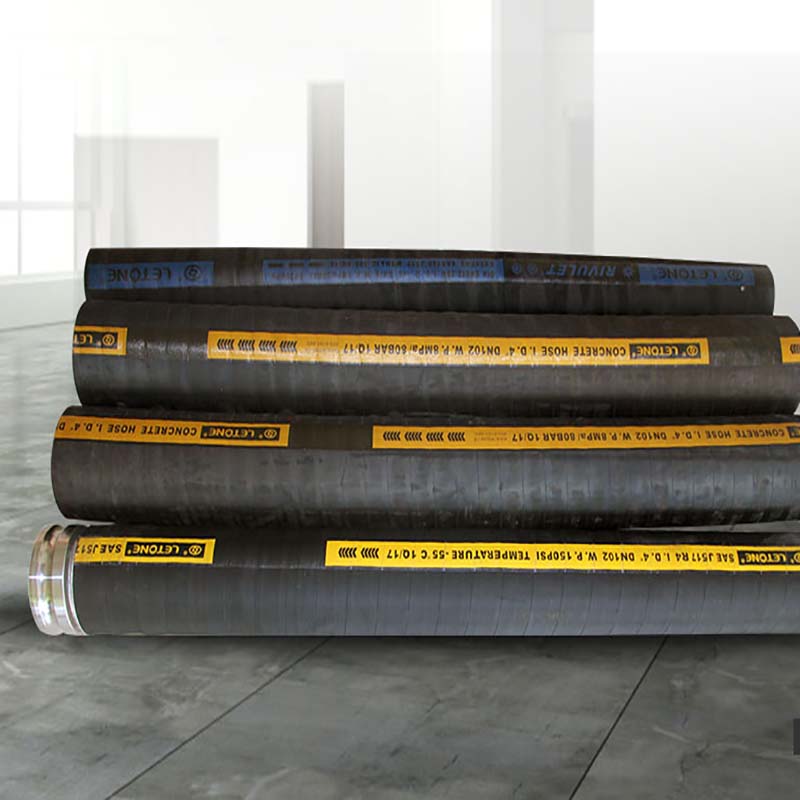In the context of modern industrialization, wear-resistant sandblasting hoses have become an indispensable and important equipment in many industries. Its excellent wear resistance and elasticity make it outstanding under various extreme conditions. Whether in the construction industry, metallurgical industry, or chemical and mining fields, sandblasting hoses have demonstrated their irreplaceable superiority. This article will delve into the various characteristics, industrial applications, installation and maintenance, as well as market prospects of wear-resistant sandblasting rubber hoses.
1、 Structure and characteristics of wear-resistant sandblasting rubber hose
The wear-resistant sandblasting hose is mainly composed of an inner layer of adhesive, an outer layer of adhesive, and a reinforcement layer. The inner glue is made of high wear-resistant materials, which can effectively reduce the friction loss of the internal fluid on the pipe wall, while the outer glue is made of high-strength, anti-aging materials to prevent the damage of the external environment to the rubber pipe. At the same time, its reinforcement layer usually uses high-strength fibers to improve the pressure resistance and tensile performance of the hose. The following are several significant characteristics of wear-resistant sandblasting rubber hoses:
1. Excellent wear resistance: The inner layer of rubber contains various additives such as wear-resistant carbon black, which can effectively extend its service life. Compared with ordinary rubber hoses, its service life can be increased by more than three times.
2. Excellent compressive performance: The multi-layer design can withstand high working pressure and is suitable for high-speed transportation of solid materials or suspensions.
3. Flexibility and corrosion resistance: In complex working environments, the flexibility of rubber hoses makes them easy to install and operate. Choosing materials with excellent corrosion resistance as the inner and outer layer adhesives also enables the rubber hose to resist the invasion of chemical substances.
4. Wide temperature adaptability: The wear-resistant sandblasting hose can work normally in the temperature range of -40 ℃ to 100 ℃ and adapt to different climatic conditions.
2、 Diversity in industrial applications
Wear resistant sandblasting rubber hoses have been widely used in multiple industries. According to its purpose, it mainly manifests in the following aspects:
1. Sand and gravel transportation in the construction industry: used to transport granular materials such as sand and gravel, cement, etc. in construction sites. Due to the wear resistance of the rubber hose, it avoids the wear problem caused by frequent transportation of high hardness materials.
2. Metallurgy and steel industry: used for transporting ore powder, slag, etc., playing an important role in the smelting process. Whether it is a continuous production line or an intermittent conveying process, it can maintain stable performance.
3. Chemical and pharmaceutical industries: can be used to transport chemical or pharmaceutical powders, ensuring the purity of materials and avoiding contamination. Especially its corrosion resistance greatly reduces the risk of damage and leakage in chemical environments.
4. Material loading and unloading at ports and ships: Sandblasting rubber hoses are also particularly important in port material loading and unloading operations, as they can efficiently transport bulk materials such as iron ore and coal.
5. Mining and tunnel excavation: As part of the soil discharge equipment, the wear resistance ensures long-term operation in strong wear environments.
3、 Key points of installation and maintenance
To ensure the long-term use of wear-resistant sandblasting rubber hoses, correct installation and daily maintenance cannot be ignored.
1. Installation precautions: During the installation process, ensure that the rubber hose is not excessively bent or compressed by external forces to avoid affecting the smoothness of fluid transportation. Suitable joint models should be used at the connection point, and pressure testing should be conducted after tightening to check its sealing performance.
2. Daily maintenance: Regularly inspect the appearance, joints, and surface of the rubber hose. If cracks or abnormal wear are found, they should be replaced in a timely manner. At the same time, it is necessary to keep the surrounding environment clean and avoid sharp objects piercing.
3. Storage environment: When not in use, it is recommended to store the wear-resistant sandblasting hose in a dry and dark environment to prevent direct sunlight from causing material aging.
4、 Market prospects and development trends
With the gradual upgrading of industry technology, the market prospects for wear-resistant sandblasting hoses are promising. Driven by intelligent manufacturing and green industry, the demand for high-performance and high-efficiency conveying equipment from enterprises is constantly increasing. From the current perspective, the future development trends are mainly reflected in the following aspects:
1. Innovation in material technology: With the breakthrough of new material technology, future wear-resistant sandblasting hoses will be lighter, more efficient, and have higher wear and corrosion resistance.
2. Sustainable development: Manufacturers will pay more attention to the environmental performance of their products, including the use of renewable materials and promoting the recycling of rubber hoses.
3. Intelligent management: Combined with IoT technology, future sandblasting hoses may be embedded with intelligent chips to achieve remote monitoring and predictive maintenance.
4. Expansion of regional markets: Against the backdrop of increasing infrastructure investment, the demand for wear-resistant rubber hoses in the Asia Pacific region is steadily rising, becoming an important driving force for global market growth.
In summary, wear-resistant sandblasting rubber hoses have become a crucial component in various industries. With the advancement of technology and the growth of demand, its application will become increasingly widespread. Enterprises should choose suitable products based on actual needs during the selection and use process, and fully utilize their economic benefits and performance through scientific management and maintenance.

